Fabaceae
Also known as the Legume or Pea Family.
Herbs, vines, shrubs, or trees.
- Flowers perfect, bilaterally symmetrical. Sepals usually 5, fused. Petals 5, most free. Stamens 10 or numerous. Pistil simple, ovary superior, carpel 1.
- Fruit a legume (or loment).
- Leaves usually compound, alternate, stipulate. Leaflets often entire-margined. Petioles and petiolules with a pulvinus.
- About 600 genera, 13,000 species, cosmopolitan.
This large family contains many familiar foods: Arachis (peanut), Glycine (soybean), Lens (lentils), Medicago (alfalafa), Phaseolus (beans), Pisum (peas), and Trifolium (clover).
It also includes ornamental plants: Lathyrus (sweet pea), Laburnum (golden-chain tree), Wisteria, and Cytisus (broom).
Flowers
| The flowers of the members of the pea families have a common appearance. They have five petals. The banner, pictured below, is only one petal. There are two lateral petals, called wingsr. In the flower pictured below the remaining two petals, together called the keel, are not noticeable. Often the keel is tucked away inside the flower and pops out once a pollinator comes to visit. the male and female reproductive structures are usually concealed within the two petals of the keel. |
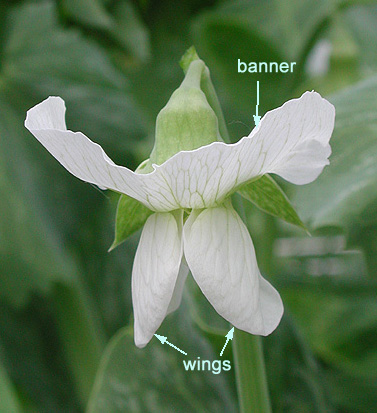 Common Flower Morphology of Fabaceae |
| In the picture below, of the flower, you can see all of the petals. The keel may be made up of two fused or independent petals. |
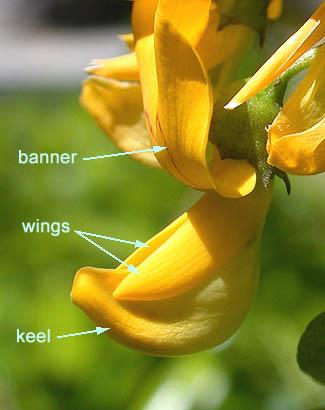 Flower, Illustrating the Keel |
Fruits
The fruits of this family are legumes: a fruit formed from 1 carpel, dry and usually dehiscent (splitting) along two sutures at maturity.
| A pea pod is a legume formed from a pistil which is composed of a single carpel. |
 Pea Pod |
| The picture below shows the pod split and the peas (seeds) still attached. |
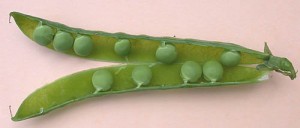 Split Pea Pod |
| This next picture is a cross-sectional view through the pod. |
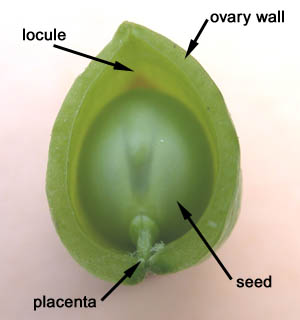 Pea Pod, Cross Section |
| Here are some immature legumes of a broom plant. |
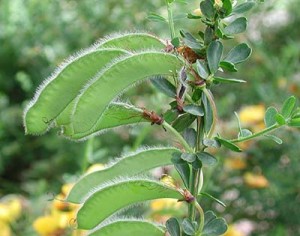 Legumes of a Broom Plant |
| The legumes dry as they mature. We usually harvest legumes well before they are mature. |
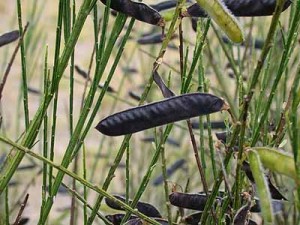 Mature Legume |
| Notice how the fruits dehisce(split) along 2 sutures. |
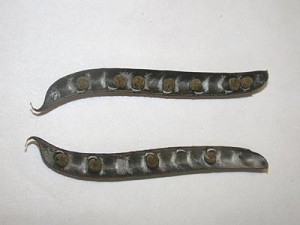 Lines of Dehiscence |
| In the wild, the fruit breaks open and twist, flinging the seeds. You can see the twisted legumes of a lupin below. This seed dispersal mechanism is very common in the Fabaceae. |
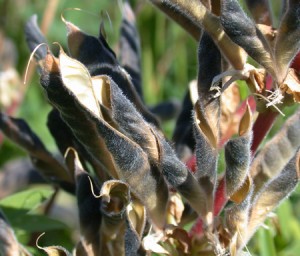 Dry and Twisted Legumes |
Other Members of the Fabaceae
Trifolium – clover.
|
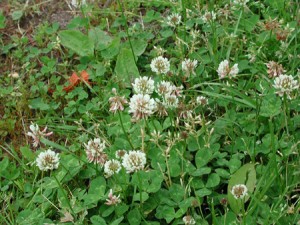 Clover Plant |
| The small inflorescence is actually a capitate spike. |
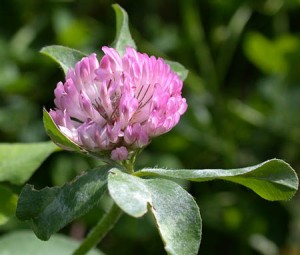 Terminal Spike of Inflorescence |
Wisteria. This lovely cascading vine is commonly grown on trellises.
|
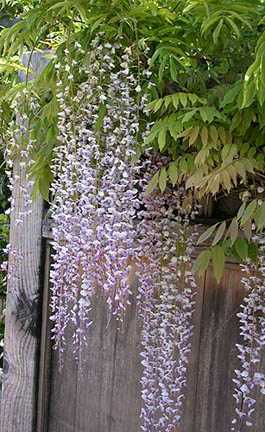 Wisteria Vine |
| A close-up of the flowers of Wysteria. |
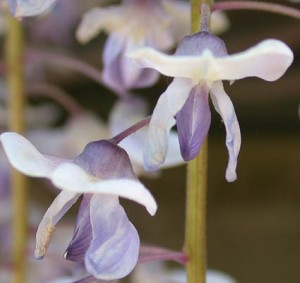 Wisteria Flower |
Melilotus – white sweet clover. This is a common plant of disturbed sites.
|
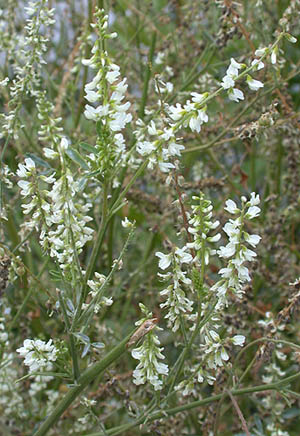 Sweet Clover |
| The flowers are said to be in spikelike racemes (Hitchcock). What do you think? |
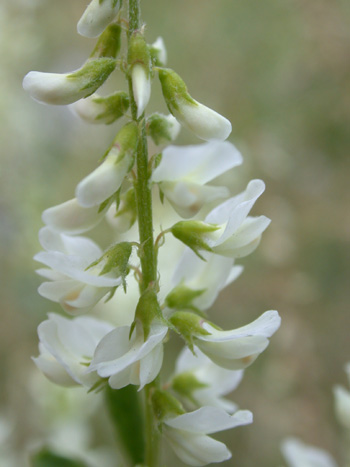 Flowers of Sweet Clover |
| The legumes (usually indehiscent) are ovoid and contain about 4 seeds. |
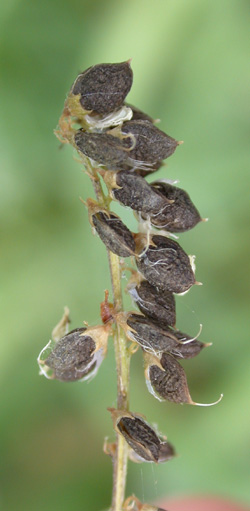 Mature Fruits of Sweet Clover |
Colutea arborescens – bladder senna. This small tree is growing behind the Math Building.
|
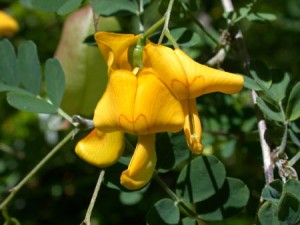 Bladder Senna |
| Can you identify the different petals of this flower? |
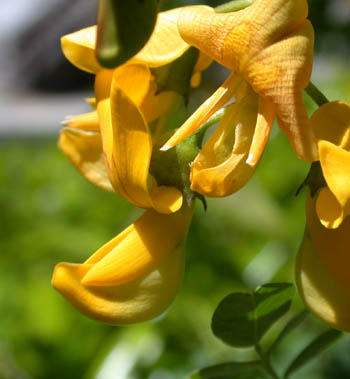 Flower of Bladder Senna |
| Here you can see that the keel has been “tripped” by a pollinator. |
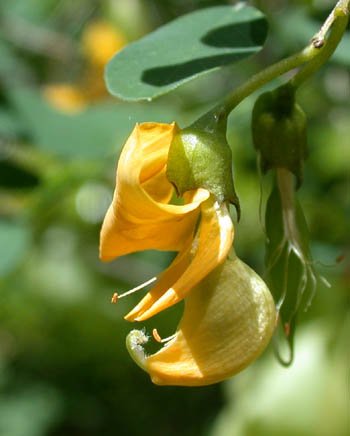 Flower of Bladder Senna, Side View |
| This plant has very cool inflated legumes. |
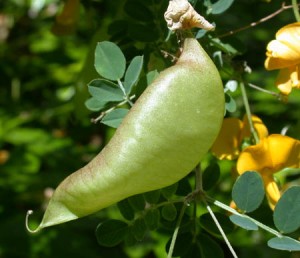 Bladder Senna, Inflated Legumes |
Coronilla varia – crown vetch. You have already seen this plant in the “fruit” section of this lab. It was introduced from the Old World.
|
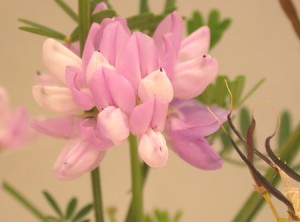 Coronilla varia |
| Here is a picture of the entire flower above and the flower with the sepals and petals removed below. The arrow indicates a stamen. |
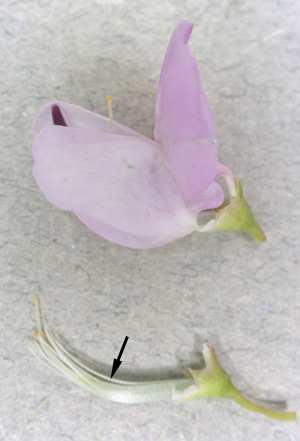 Coronilla varia Flower, with petals removed in Bottom Flower |
Tamarindus indica (tamarind)
Tamarind’s origin is in Africa where it has long been used in cooking. In North America you will find it in such off-the-shelf products as HP Steak Sauce. Tamarind is used in Indian cuisine as an important compoenet to chutneys and sauces. The outer ovary wall is removed and the brown paste-like inner ovary wall is collected. The seeds can be roasted and eaten after the seed coatis removed. |
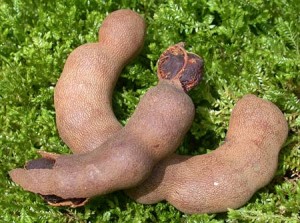 Tamarind |
| Vigna unguiculata var. sesquipedalis. The common name of this long bean is the yard-long bean. It was originally domesticated in Ethiopia from V. unguiculata (cow peas). |
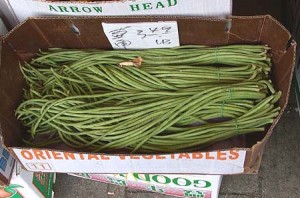 Long Beans |
Back to Lab 4
























